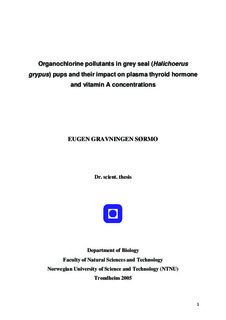| dc.contributor.author | Sørmo, Eugen Gravningen | nb_NO |
| dc.date.accessioned | 2014-12-19T13:11:25Z | |
| dc.date.available | 2014-12-19T13:11:25Z | |
| dc.date.created | 2006-02-20 | nb_NO |
| dc.date.issued | 2005 | nb_NO |
| dc.identifier | 125859 | nb_NO |
| dc.identifier.isbn | 82-471-7079-5 | nb_NO |
| dc.identifier.uri | http://hdl.handle.net/11250/244631 | |
| dc.description.abstract | Studies on laboratory animals suggest that developing and newborn mammals are more vulnerable than the adults with respect to the harmful effects of organochlorine (OC) pollutants such polychlorinated biphenyls (PCBs) and OC pesticides (Brouwer et al. 1995; 1998a; Colborn 2004). These effects include neurobiological and neurochemical effects, reproductive effects, reduced brain and circulatory thyroid hormone levels, impaired immune functions and vitamin A homeostasis (Brouwer et al. 1995; Colborn 2004; Safe et al. 1994; Tryphonas 1994). In humans, several of these negative effects of OCs have been reported in children of mothers with high pollutant burdens (Jacobson and Jacobson 1996, 1997; Koopman-Esseboom et al. 1994; Sandau et al. 2002; ten Tusscher et al 2003; Weisglas- Kuperus et al. 2000, 2004). Most organochlorines are highly lipophilic and resistant against degradation, and biomagnify as a function of the trophic level in food webs. Due to long food chains and the lipid richness of marine ecosystems, marine apex predators, such as seals, often accumulate very high burdens of these compounds (Aquilar et al. 2002), exemplifying the particular concern about toxic effects in these species. Studies of newborn phocid seals may be particularly interesting, because seals have lipid rich milk, resulting in the nursed grey seal pups being exposed to relatively high concentrations of OCs (Addison and Brodie 1977, 1987: Addison et al. 1999; Debier et al. 2003; Green et al. 1996; Pomeroy et al. 1996; Schweigert and Stobo 1994) during a period of their life when their endocrine and neural systems are still under development, and under the influence of the potentially disruptive properties of these pollutants (Hall et al. 1998; Simms et al. 2000b).
Particularly high concentrations of OCs have been found in seals from the Baltic Sea as compared to seals from the North-Atlantic Ocean (Jenssen 1996; Nyman et al. 2002), and it has been suggested that these high exposure levels severely affects the health of Baltic seals (Bergman 1999; Bergman et al. 2001; Helle et al. 1976a,b; Nyman et al. 2001, 2003; Olsson et al. 1994). Given that the developing mammal might be particularly susceptible to the effects of OCs, it is of special interest to examine possible OC related effects that newborn seals may suffer from. Results from such a study may also predict the effects of OCs on marine mammals in general and possibly on humans (Jenssen 2003). | nb_NO |
| dc.language | eng | nb_NO |
| dc.publisher | Fakultet for naturvitenskap og teknologi | nb_NO |
| dc.relation.ispartofseries | Doktoravhandlinger ved NTNU, 1503-8181; 2005:101 | nb_NO |
| dc.relation.haspart | Sørmo, EG; Skaare, JU; Lydersen, C; Kovacs, KM; Hammill, MO; Jenssen, BM. Partitioning of persistent organic pollutants in grey seal (Halichoerus grypus) mother–pup pairs. The Science of The Total Environment. 302(1-3): 145-155, 2003. | nb_NO |
| dc.relation.haspart | Sørmo, EG; Skaare, JU; Jüssi, I; Jüssi, M; Jenssen, BM. Polychlorinated biphenyls and organochlorine pesticides in Baltic and Atlantic gray seal (halichoerus grypus) pups. Environmental Toxicology and Chemistry. 22(11): 2789-2799, 2003. | nb_NO |
| dc.relation.haspart | Sørmo, EG; Jüssi, I; Jüssi, M; Braathen, M; Skaare, JU; Jenssen, BM. Thyroid hormone status in Baltic and Atlantic grey seal (Halichoerus grypus) pups in relation to polychlorinated biphenyls and organochlorine pesticides. Environmental Toxicology and Chemistry. 24(3): 610-616, 2005. | nb_NO |
| dc.relation.haspart | Jenssen, BM; Haugen, O; Sørmo, EG; Skaare, JU. Negative relationship between PCBs and plasma retinol in low-contaminated free-ranging gray seal pups (Halichoerus grypus). Environmental Research. 93(1): 79-87, 2003. | nb_NO |
| dc.subject | NATURAL SCIENCES: Biology | en_GB |
| dc.title | Organochlorine pollutants in grey seal (Halichoerus grypus) pups and their impact on plasma thyroid hormone and vitamin A concentrations | nb_NO |
| dc.type | Doctoral thesis | nb_NO |
| dc.contributor.department | Norges teknisk-naturvitenskapelige universitet, Fakultet for naturvitenskap og teknologi, Institutt for biologi | nb_NO |
| dc.description.degree | dr.scient. | nb_NO |
| dc.description.degree | dr.scient. | en_GB |
